(龙腾网)马来西亚最后一只雄性苏门答腊犀牛寿终正寝
(龙腾网)马来西亚最后一只雄性苏门答腊犀牛寿终正寝
原创翻译:龙腾网
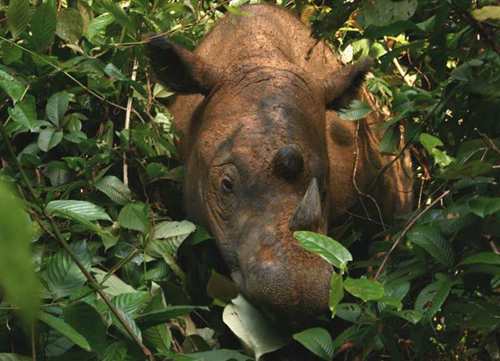
(译注:苏门答腊犀为分布于亚洲的三种犀牛之一,野生寿命可超过30岁,目前仅存于马来西亚和印尼的苏门答腊岛,野外种群数量只有百头上下,中国境内的最后一只苏门答腊犀于1945年射杀于云南)
Rhino die every day, so why is the worldmourning the loss of Tam? Tam was the last male Sumatran rhinoceros in Malaysiaand was thought to have died of old age in his thirties – elderly for aSumatran rhino. He was taken from the wild in 2008 to a sanctuary in MalaysianBorneo. His health had been deteriorating since April 2019 and he finallysuccumbed in May. He is survived by a single female, Iman, who cannot reproducedue to a ruptured tumour in her uterus.
每天都有犀牛在死去,那么为什么全世界会为丹的离去而哀悼呢?丹是马来西亚最后一只雄性苏门答腊犀,被认为是老死的,享年三十多岁,对苏门答腊犀牛来说属于老年人了。他于2008年自野外捕获,送进了马来西亚婆罗洲的禁猎区。他的健康自2019年4月以来一直在恶化,最终在五月份咽了气。他和一只雌性犀牛一起幸存了下来,后者由于子宫内的肿瘤破裂而无法生育。
The news isn’t good, but an estimated 80inp>
这可不是条好消息,但据估计,在印度尼西亚的野外还有80头幸存,这个数字并不多,但情况要比爪哇犀好一些,后者可能只剩58头了。相较之下,引起了极大关注的非洲白犀牛,其数量被认为是2万头。但世界上体型最小且毛发最多的苏门答腊犀牛,其种群数量在过去的二十年间已经下降了70%,主要是因为偷猎和栖息地的丧失,现在被归入了极度濒危物种(极危),这是灭绝风险最高的一个门类。
The majority of the remaining Sumatranrhino are reckoned to be on Sumatra – the largest island of Indonesia – with ahandful likely in the wild in Indonesian Borneo. For such a rare species with ascattered distribution that lives in dense mountain forests, uating thepopulation size isn’t easy. Camera trapping is the main tool for counting thisrelatively diminutive and shy rhino, but even confidence in the estimate of 80inp>
据估计,剩余的大部分苏门答腊犀生活在印尼最大的岛屿苏门答腊岛上,而存在于印尼婆罗洲野外的苏门答腊犀,可能一只手就数得过来。作为一种如此稀有的物种,分布地区极其分散,还生活在深山老林中,要估算其种群数量是不太容易的。要计算这种体型相对娇小且害羞的犀牛数量,相机陷阱是主要的手段,但就算对估算出的80头很有信心,这个数字也不高。有可能实际存在的数量更多,也可能更少,少至30头都是有可能的。
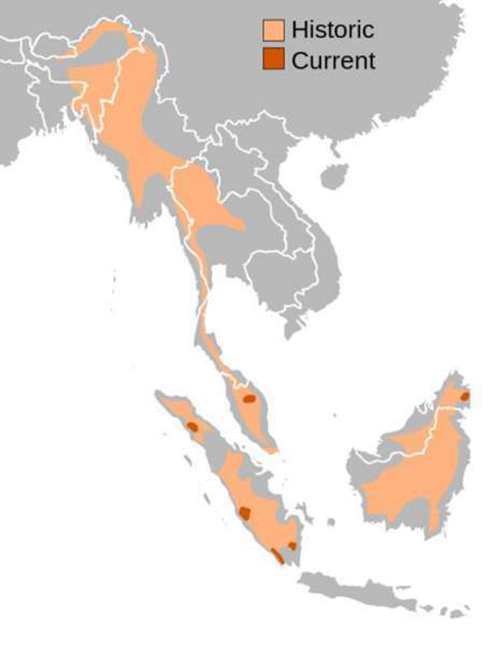
Sumatran rhino once roamed across Asia,from south-east India, Bangladesh, Myanmar and Thailand to the islands ofSumatra and Borneo. It’s believed the wild Malaysian populations are nowextinct. There may be a small population in Kalimantan, Indonesian Borneo. Eric Dinerstein/Wikipedia
(图解:苏门答腊犀曾经漫步于整个亚洲,从印度东南部、孟加拉国、缅甸、泰国,到苏门答腊岛和婆罗洲均有分布。人们相信,野生的马拉西亚种群现在已经灭绝了。在加里曼丹岛上印尼的婆罗洲地区,可能还有极少量的种群存在)

A young female called Pahu – whose foresthabitat was literally being removed from under her feet by mining companies –was captured in 2018 and is apparently doing well in captivity. Sadly, there isa risk to this strategy. By removing rhino from their habitat, we furtherreduce the probability of them breeding successfully in the wild.
有一只叫帕胡的年轻雌性犀牛,捕获于2018年,显然在圈养状态下表现良好。而让人难过的是,这种策略存在一种风险。把犀牛从它们的栖息地中迁走,那我们就进一步降低了其在野外成功繁殖的可能性。
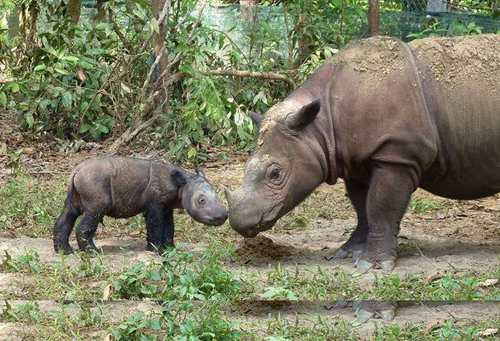
Mother, Ratu, with four-month-old Andatu atthe Sumatran Rhino Sanctuary in Way Kambas National Park, Indonesia. International Rhino Foundation/Wikipedia, CCBY
(图解:母亲拉图和四个月大的安达图,印度尼西亚威坎巴斯国家公园中的苏门答腊犀禁猎区)
As an ecologist, captive breeding issomething that I find hard to celebrate. But it may be the only hope to save aspecies that, otherwise, appears doomed to slowly dwindle into extinction.
我作为一个生态学家,人工繁殖是我很难去称赞的方式。但这可能是挽救一个物种唯一的希望,不然的话,它们似乎注定会缓慢减少,乃至灭绝。
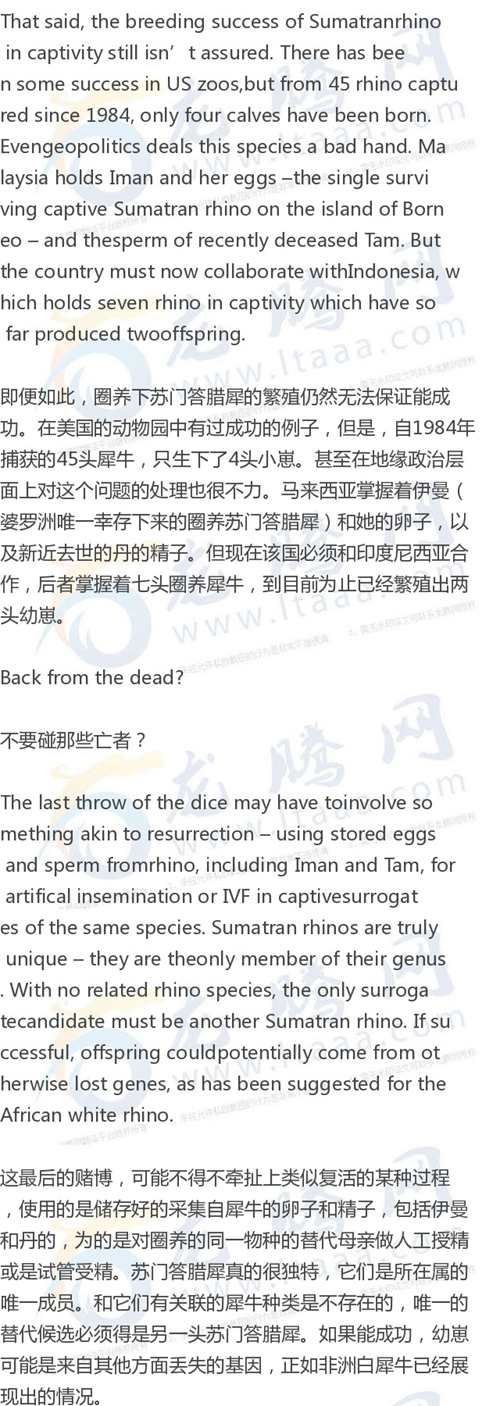
(译注:苏门答腊犀属于双角犀属,是这个属里唯一的物种)
While the science is developing,“de-extinction” is still an expensive and unlikely long shot that raises itsown practical and ethical dilemmas. If successful, we could end up farming anecologically dead species. I want wild animals to be in the wild contributingto the ecosystems within which they evolved – not living in zoos forever.
虽然相关科学正在发展,“摆脱灭绝”仍然是耗资巨大且不太可能实现的大冒险,这也引发了其实际操作和伦理方面的困境。如果能成功,我们就不用再蓄养在生态角度看已经死亡的物种。我希望野生动物能生活在野外,对生态系统有所贡献,并在其中演化,而不是永远生活在动物园里。
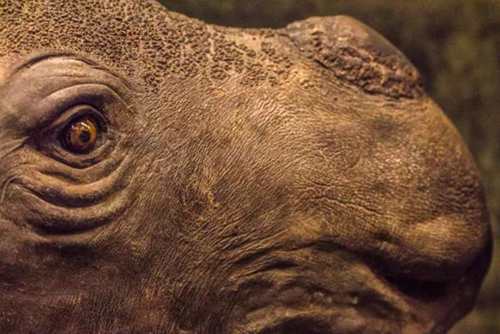
An adolescent male Sumatran Rhino, killedby a stake when it fell into a trap in 1900. Now resident at the NationalMuseum of Scotland. Jason Gilchrist,Author provided (No reuse)
(图解:一只亚成体的雄性苏门答腊犀,于1900年跌入陷阱并被一根木桩所杀。现成为了苏格兰国家博物馆的展品)
Both modes of rescue – captive breeding andgenetic resurrection – are too little, too late, like firefighters takingaction when the damage is already too far gone. The longer that society waitsto help a declining species, the greater the delay in addressing the drivingforces of endangerment, be they poaching, habitat loss, non-native species, orclimate change. And the lower the probability of success, and the greater thecost of the attempt.
两种拯救的方式,人工繁殖和用基因复活都太微不足道了,也太迟了,就像消防员在损失已经不可挽回的时候采取行动。我们的社会在救助一个衰亡中的物种上等待的时间越久,处理那些会带来危害的动因时就越严重地被耽搁,它们可以是偷猎,是栖息地丧失,是外来物种或是气候变化。而成功的可能性越低,这种尝试的耗费就越大。
So, Tam was just one rhino. He was not thelast of his species, or even the last male of his species, but he is one moreloss from an already limited population. The lower the population size, thegreater the impact of losing another inp>
所以,丹只是一头犀牛而已。他并不是他这个物种的最后一位成员,甚至都不是他这个物种的最后一头雄性,但他是这个数量已经很有限的种群的又一次损失。种群规模越小,再失去一个个体对种群的冲击就越大。丹的死去是又一次警钟,就我们从速行动以消除这些对物种的威胁乃至最终拯救地球生命方面的无能,给我们提出了警告。现在每一头死去的苏门答腊犀都得到了宣传和关注。这么做是正确的,但是为了让保育行动能够奏效,我们必须尽可能早地让保育行动以正确的方式开展。
(本文作者Jason Gilchrist为来自爱丁堡龙比亚大学的生态学家)
评论翻译
原创翻译:龙腾网
1、Please continueto save the Sumatran rhinos and get rid of all the poachers because since thelast Malaysian male died, we really need to boost their numbers back up ifwe’re going to save this wonderful smallest member of the Rhino family becauseI care a lot about them and other rhinos as well as all Wildlife around theworld.
请继续拯救这些苏门答腊犀,并除掉所有的偷猎者,因为由于马来西亚最后的雄犀死去了,如果我们打算拯救这种美妙的犀牛家族中最小的成员,我们就真的必须让它们的数量回升,因为我很是在乎它们以及其他犀牛,乃至全世界所有的野生动物。
2、It would havebeen nice to mention that one of the males in Way Kambas is Harapan, born inthe US and returned to Indonesia to help save his species as a young animal.Now 12 years old, it is hoped he will start breeding soon.
有件事如果能体贴地提一下就好了,威坎巴斯国家公园里的其中一头雄犀叫哈拉潘,出生于美国并在年轻时返回了印度尼西亚,为的就是帮助他这个物种。现在他已经12岁了,希望他能很快开始繁殖。
以上就是((龙腾网)马来西亚最后一只雄性苏门答腊犀牛寿终正寝)全部内容,收藏起来下次访问不迷路!